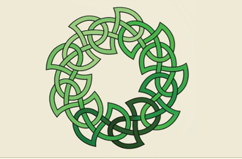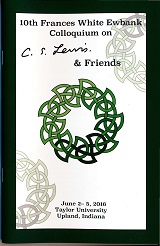Event Title
Paper Session 3-B: Science and Worldview
Location
Euler 108
Start Date
3-6-2016 11:00 AM
Description
"Strange Bedfellows: C. S. Lewis and Fred Hoyle" - Kristine Larsen
C.S. Lewis was known to friends as a well-read aficionado of both modern and medieval astronomy. He embraced a pre-Copernican universe (with its astrological overtones) in The Chronicles of Narnia and defended the beauty and relevance of the geocentric model in The Discarded Image. In the Space Trilogy Ransom travels to Lewis's visions of Mars and Venus, where he interacts with intelligent extraterrestrials, battles evil scientists, and aids in the continuation of extraterrestrial Christian values. In real life, one of Lewis's favorite scientific targets was unabashed atheist Fred Hoyle, whom he and friend Dorothy L. Sayers openly criticized, both for Hoyle's anti-Christian statements as well as the scientific community's apparent inconsistencies in terms of declaring the likelihood (or not) of extraterrestrial life. Interestingly, Lewis included a fairly correct description of red giants in two novels in the Narnia series (The Magician's Nephew and The Last Battle), despite the fact that Hoyle was well-known as one of the pioneers in the field of stellar death and the properties of red giants. This paper will explore the curious intellectual relationship between Lewis and Hoyle in light of astronomical theory circa 1950.
"Critical Realism, Science, and C. S. Lewis's The Abolition of Man" - Dan Ippolito
Modern science takes for granted the validity of methodological uniformitarianism and the Principle of Parsimony. It also rests on the belief that the universe is rationally ordered and therefore accessible to human reason. In other words, science requires an act of faith just in order to get started. In this regard it is analogous to C. S. Lewis' concept of the Tao elaborated upon in The Abolition of Man. Lewis wrote, "It [the Tao] is the doctrine of objective value, the belief that certain attitudes are really true, and others really false, to the kind of thing the universe is." In this paper I am proposing to substitute "trust that external reality is real and knowable" for Lewis' "objective values." I will conclude that the modern scientific enterprise rests on three foundational assumptions, namely, trust that the universe is real and accessible to our senses, trust in the Principle of Parsimony, and an a priori belief in the spatial and temporal invariance of natural laws. These assumptions "neither demand nor admit proof" - they are beliefs about the sort of thing the Universe is and how it works.
"Finding the Fox that isn't There: Discovering Unity in a History of Disparity" - Zachary Rhone
For nearly thirty years, the Inklings met weekly in Oxford, and the rest made history. In the early 1960s, Inkling member John Wain claimed that the Inklings had a unified worldview. Supporter of the premise soon appeared, such as Marjorie Evelyn Wright, Roger Sale, Charles Moorman, Lee Donald Rossi, and Leo A. Hetzler. In 1978, however, Humphrey Carpenter wrote the first major biography of the Inklings, dedicating the entire chapter, "A fox that isn't there," to decry any unity in the group's worldview. Scholars to follow, instead of recognizing unity, followed Carpenter's queue of disparity for the following thirty-eight years. My presentation will not only catalogue these historical developments but also abrogate the dominate atmosphere of disunity in Inkling scholarship. My approach will respond to the evidence offered for disunity in these authors' worldview noting, in particular, how the worldviews of Tolkien, Lewis, Chesterton, and MacDonald are unified. This discussion prefaces the argument of my forthcoming book from Kent State University Press, The Great Tower of Elfland: The Unified Worldview of J. R. R. Tolkien, C. S. Lewis, G. K. Chesterton, and George MacDonald.
Event Type
Paper
Paper Session 3-B: Science and Worldview
Euler 108
"Strange Bedfellows: C. S. Lewis and Fred Hoyle" - Kristine Larsen
C.S. Lewis was known to friends as a well-read aficionado of both modern and medieval astronomy. He embraced a pre-Copernican universe (with its astrological overtones) in The Chronicles of Narnia and defended the beauty and relevance of the geocentric model in The Discarded Image. In the Space Trilogy Ransom travels to Lewis's visions of Mars and Venus, where he interacts with intelligent extraterrestrials, battles evil scientists, and aids in the continuation of extraterrestrial Christian values. In real life, one of Lewis's favorite scientific targets was unabashed atheist Fred Hoyle, whom he and friend Dorothy L. Sayers openly criticized, both for Hoyle's anti-Christian statements as well as the scientific community's apparent inconsistencies in terms of declaring the likelihood (or not) of extraterrestrial life. Interestingly, Lewis included a fairly correct description of red giants in two novels in the Narnia series (The Magician's Nephew and The Last Battle), despite the fact that Hoyle was well-known as one of the pioneers in the field of stellar death and the properties of red giants. This paper will explore the curious intellectual relationship between Lewis and Hoyle in light of astronomical theory circa 1950.
"Critical Realism, Science, and C. S. Lewis's The Abolition of Man" - Dan Ippolito
Modern science takes for granted the validity of methodological uniformitarianism and the Principle of Parsimony. It also rests on the belief that the universe is rationally ordered and therefore accessible to human reason. In other words, science requires an act of faith just in order to get started. In this regard it is analogous to C. S. Lewis' concept of the Tao elaborated upon in The Abolition of Man. Lewis wrote, "It [the Tao] is the doctrine of objective value, the belief that certain attitudes are really true, and others really false, to the kind of thing the universe is." In this paper I am proposing to substitute "trust that external reality is real and knowable" for Lewis' "objective values." I will conclude that the modern scientific enterprise rests on three foundational assumptions, namely, trust that the universe is real and accessible to our senses, trust in the Principle of Parsimony, and an a priori belief in the spatial and temporal invariance of natural laws. These assumptions "neither demand nor admit proof" - they are beliefs about the sort of thing the Universe is and how it works.
"Finding the Fox that isn't There: Discovering Unity in a History of Disparity" - Zachary Rhone
For nearly thirty years, the Inklings met weekly in Oxford, and the rest made history. In the early 1960s, Inkling member John Wain claimed that the Inklings had a unified worldview. Supporter of the premise soon appeared, such as Marjorie Evelyn Wright, Roger Sale, Charles Moorman, Lee Donald Rossi, and Leo A. Hetzler. In 1978, however, Humphrey Carpenter wrote the first major biography of the Inklings, dedicating the entire chapter, "A fox that isn't there," to decry any unity in the group's worldview. Scholars to follow, instead of recognizing unity, followed Carpenter's queue of disparity for the following thirty-eight years. My presentation will not only catalogue these historical developments but also abrogate the dominate atmosphere of disunity in Inkling scholarship. My approach will respond to the evidence offered for disunity in these authors' worldview noting, in particular, how the worldviews of Tolkien, Lewis, Chesterton, and MacDonald are unified. This discussion prefaces the argument of my forthcoming book from Kent State University Press, The Great Tower of Elfland: The Unified Worldview of J. R. R. Tolkien, C. S. Lewis, G. K. Chesterton, and George MacDonald.


